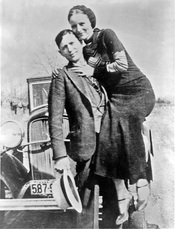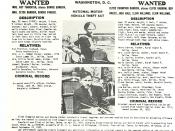"I'm leaving for St. Petersburg, Florida, tomorrow. Let the worthy citizens of Chicago get their liquor the best they can. I'm sick of the job. It's a thankless one and full of grief....I've been spending the best years of my life as a public benefactor" (Torricelli 85). As Capone himself accurately describes, his job was seen as one of a "benefactor" whereby he produced a much-desired commodity withheld by the government. Consequential to the institution of prohibition during the twenties, the consummation of a marriage between crime lord and citizen occurred. For the first major time during American history, the average man and the criminal became co-conspirators against an overly oppressive government, made manifest by the likes of Al Capone, John Dillinger, Baby Face Nelson, Bonnie and Clyde, and Pretty Boy Floyd. These crime figures of the twenties were hoisted by society to iconic positions, revealing a profound detachment between the citizenry and the government.
Only shortly after Alphonse Capone began his professional career, society became, and still remains, entranced. Upwards of fifteen motion pictures and video documentaries have been created about him. His name and fame have appeared in excess books, newspapers, and magazines since the apex of his success in racketeering in Chicago. However, Capone entered one specific, cathartic reclusion that acted as a springboard for social embracement. After accidentally having a young prosecutor killed, the public cried for Capone's blood and he was forced into hiding during the summer months. Here, at the nadir of his career, he began to think of himself as "benefactor" to the masses and an icon for Italian immigrants wishing to move up in status. Therefore, when Capone returned to the public's attention, he surrendered to the police for the prosecutor case (but conviction was prevented by a lack of evidence). In...



Very Good
This was a very well-written essay and I enjoyed reading it.
0 out of 0 people found this comment useful.